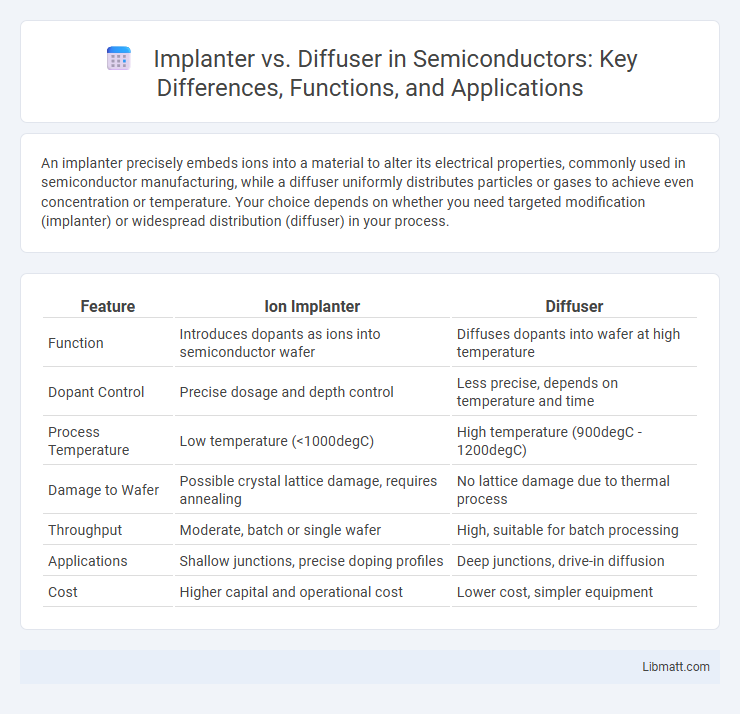An implanter precisely embeds ions into a material to alter its electrical properties, commonly used in semiconductor manufacturing, while a diffuser uniformly distributes particles or gases to achieve even concentration or temperature. Your choice depends on whether you need targeted modification (implanter) or widespread distribution (diffuser) in your process.
Table of Comparison
| Feature | Ion Implanter | Diffuser |
|---|---|---|
| Function | Introduces dopants as ions into semiconductor wafer | Diffuses dopants into wafer at high temperature |
| Dopant Control | Precise dosage and depth control | Less precise, depends on temperature and time |
| Process Temperature | Low temperature (<1000degC) | High temperature (900degC - 1200degC) |
| Damage to Wafer | Possible crystal lattice damage, requires annealing | No lattice damage due to thermal process |
| Throughput | Moderate, batch or single wafer | High, suitable for batch processing |
| Applications | Shallow junctions, precise doping profiles | Deep junctions, drive-in diffusion |
| Cost | Higher capital and operational cost | Lower cost, simpler equipment |
Understanding Implanters and Diffusers
Implanters and diffusers are essential tools in semiconductor manufacturing used for modifying material properties at the atomic level. Implanters precisely inject ions into substrates, enabling controlled doping to alter electrical characteristics, while diffusers rely on thermal processes to redistribute these ions within the material. Understanding the differences in mechanism and application of implanters versus diffusers is critical for optimizing semiconductor device performance and manufacturing efficiency.
Key Differences: Implanter vs Diffuser
Implanters deliver concentrated energy directly into targeted tissue for precise treatment, while diffusers disperse energy over a broader area to provide uniform coverage. Your choice between an implanter and a diffuser depends on the specific medical or cosmetic application, such as focused cellular therapy versus surface-level skin rejuvenation. Understanding these key differences ensures optimal results by matching the device's energy distribution method to your treatment goals.
How Implanters Work
Implanters operate by precisely injecting dopant ions into semiconductor wafers using high-energy ion beams, enabling controlled alteration of electrical properties in specific regions. The process involves accelerating ions through an electric field and directing them onto the wafer surface, where they penetrate to a predetermined depth. This targeted doping technique achieves uniform concentration profiles essential for fabricating integrated circuits with high performance and reliability.
How Diffusers Function
Diffusers function by dispersing essential oils into the air using ultrasonic vibrations or heat, which breaks the oils into tiny particles, allowing for even distribution and improved air quality. This method enhances your environment by providing continuous fragrance and potential therapeutic benefits without using needles or invasive tools. Unlike an implanter, which physically places substances beneath the skin, diffusers offer a non-invasive way to enjoy aromatherapy and create a calming atmosphere.
Advantages of Using Implanters
Implanters offer precise ion placement, enhancing device performance by reducing lattice damage compared to diffusers. They enable selective doping with controlled depth and concentration profiles, critical for advanced semiconductor manufacturing. This accuracy supports smaller feature sizes and improved electrical characteristics in integrated circuits.
Benefits of Diffusers in Practice
Diffusers offer significant benefits in practice by providing gentle and even distribution of essential oils, enhancing aromatherapy effectiveness without overpowering the senses. Unlike implanters, diffusers maintain the integrity of the oils through ultrasonic or nebulizing technology, ensuring optimal therapeutic properties are preserved. Your space becomes naturally refreshed and balanced, promoting relaxation and well-being through consistent diffusion.
Implanter Applications in Various Industries
Implanters are critical in semiconductor manufacturing, enabling precise ion implantation to modify the electrical properties of silicon wafers for integrated circuit production. These devices also play a vital role in aerospace and automotive industries, where they are used to enhance surface hardness and wear resistance of components through ion implantation techniques. In the medical field, implanters facilitate the creation of biocompatible surfaces on implants, improving their durability and performance in the human body.
Diffuser Use Cases and Effectiveness
Diffusers are highly effective in spreading essential oils evenly throughout a room, making them ideal for aromatherapy, stress relief, and improving indoor air quality. You can use diffusers in bedrooms, living rooms, and offices to create a calming atmosphere or to promote better sleep and focus. Their ability to disperse fine mist ensures consistent fragrance intensity, enhancing both mood and well-being.
Choosing Between Implanter and Diffuser
Choosing between an implanter and a diffuser depends on your specific hair transplant needs and goals. An implanter offers precise follicle placement and reduced trauma, ideal for intricate hairline design and natural density. A diffuser spreads grafts over a larger area, suitable for covering extensive hair loss efficiently while ensuring graft survival.
Frequently Asked Questions: Implanter vs Diffuser
An Implanter provides precise, targeted hair follicle placement ideal for detailed hair restoration, while a Diffuser distributes airflow evenly to reduce frizz and enhance natural curls. You might ask which tool is best for your specific hair type or treatment goals; Implanters are suited for controlled implantation during hair transplants, whereas Diffusers improve hair drying without disrupting curl patterns. Frequently asked questions often address effectiveness, usage techniques, and suitability based on hair texture or medical procedures.
Implanter vs Diffuser Infographic

 libmatt.com
libmatt.com